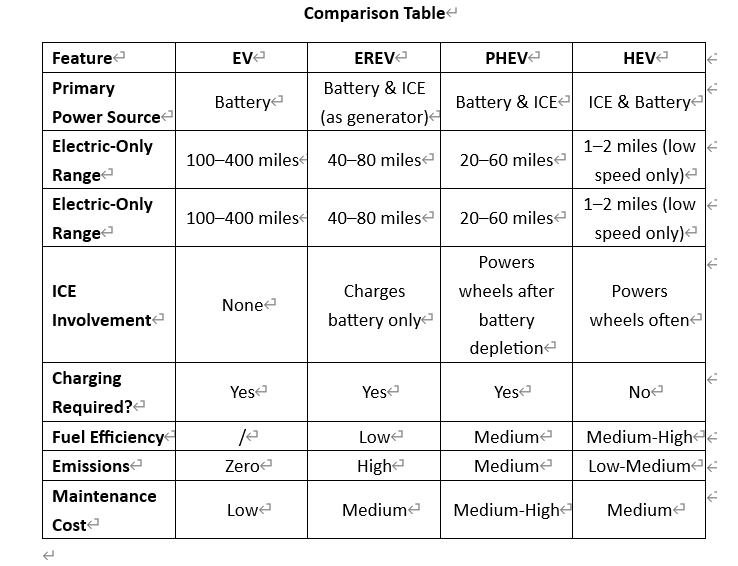Here’s a breakdown of the working principles, advantages, and disadvantages of EVs (Electric Vehicles), EREVs (Extended-Range Electric Vehicles), PHEVs (Plug-in Hybrid Electric Vehicles), and HEVs (Hybrid Electric Vehicles):
- EV (Electric Vehicle)
Working Principle
EVs are fully powered by electricity, using a battery pack to store energy and an electric motor for propulsion. They do not have an internal combustion engine (ICE) and need to be charged via an external power source.
Advantages
✅ Zero emissions – No tailpipe pollution, reducing carbon footprint.
✅ High efficiency – Electric motors convert over 90% of energy into movement, compared to 30% in gasoline engines.
✅ Lower maintenance costs – Fewer moving parts, no oil changes, or engine-related repairs.
✅ Instant torque – Provides fast acceleration and smooth driving experience.
Disadvantages
❌ Limited range – Typically 200–400 miles per charge, depending on battery capacity.
❌ Charging time & infrastructure – Charging can take minutes to hours, and public charging networks are still expanding.
❌ High upfront cost – Batteries are expensive, making EVs pricier than ICE vehicles.
________________________________________
- EREV (Extended-Range Electric Vehicle)
Working Principle
EREVs operate primarily as EVs, with an electric motor driving the wheels. However, they have a small internal combustion engine (ICE) that acts as a generator to charge the battery when it depletes, extending range. The ICE does not directly power the wheels.
Advantages
✅ EV-like operation – Runs on electricity for daily commutes (40–80 miles) before using the gas-powered generator.
✅ Extended range – Overcomes range anxiety by using gasoline for long trips.
✅ Lower fuel consumption – Uses gasoline only when necessary, reducing dependency on fossil fuels.
Disadvantages
❌ Higher complexity – Has both an electric powertrain and an ICE-based generator.
❌ Still requires gasoline – Though less frequently, it still produces emissions.
❌ Battery limitations – Smaller battery compared to full EVs, limiting all-electric range.
________________________________________
- PHEV (Plug-in Hybrid Electric Vehicle)
Working Principle
PHEVs have both an electric motor (powered by a battery) and a gasoline engine. The vehicle can operate in pure electric mode for a limited range (typically 20–60 miles) before switching to hybrid mode, where the engine and motor work together.
Advantages
✅ Electric driving for short trips – Reduces fuel consumption for daily commutes.
✅ No range anxiety – Uses gasoline for long trips if the battery runs out.
✅ Lower emissions than traditional hybrids – When charged regularly, PHEVs produce fewer emissions.
Disadvantages
❌ Heavier than conventional hybrids – The extra battery adds weight, affecting fuel efficiency in hybrid mode.
❌ Charging needed for maximum benefit – Without regular charging, it operates like a regular hybrid.
❌ More expensive than HEVs – Due to larger batteries and charging components.
________________________________________
- HEV (Hybrid Electric Vehicle)
Working Principle
HEVs use both an internal combustion engine (ICE) and an electric motor. The battery is charged through regenerative braking and the ICE, meaning HEVs cannot be plugged in. The system optimizes fuel efficiency by switching between or combining the engine and electric motor.
Advantages
✅ Better fuel efficiency than ICE cars – Uses electric power at low speeds, reducing fuel consumption.
✅ No charging required – Uses regenerative braking to recharge the battery.
✅ Lower emissions than gasoline vehicles – Burns less fuel and produces fewer pollutants.
Disadvantages
❌ Still reliant on gasoline – Cannot operate solely on electricity for long.
❌ Lower fuel savings than PHEVs/EVs – Since the battery is smaller and less powerful.
❌ Higher complexity – More components than a traditional ICE car, leading to potential repair costs.
________________________________________

Conclusion
• EVs are best for those who want zero emissions and can charge regularly.
• EREVs provide a middle ground for those who want an EV experience but with a backup generator.
• PHEVs work well for those with access to charging but need the flexibility of a gasoline engine.
• HEVs are great for improving fuel efficiency without worrying about charging.
Would you like recommendations on the best models available today? 🚗💡